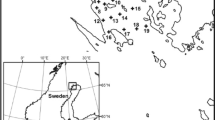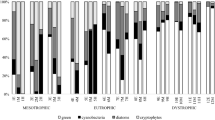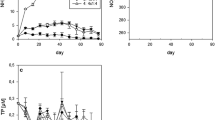Abstract
This study combined water- and sediment flux measurements with mass balances of dissolved gas and inorganic matter to determine the importance of pelagic and benthic processes for whole-system metabolism in a eutrophic fluvial lake. Mass balances of dissolved O2, inorganic carbon (DIC), nitrogen (DIN), phosphorous (SRP), particulate N (PN) and P (PP) and Chl a were calculated at a nearly monthly frequency by means of repeated sampling at the lake inlet and outlet. Simultaneously, benthic fluxes of gas and nutrients, including denitrification rates, and the biomass of the dominant pleustophyte (Trapa natans) were measured, and fluxes of O2 and CO2 across the water–atmosphere interface were estimated from diel changes in outlet concentrations. On an annual scale, Middle Lake exhibited CO2 supersaturation, averaging 313% (range 86–562%), but was autotrophic with a net O2 production (6.35 ± 2.05 mol m−2 y−1), DIC consumption (−31.18 ± 18.77 mol m−2 y−1) and net export of Chl a downstream (8.38 ± 0.95 mol C m−2 y−1). Phytoplankton was the main driver of Middle Lake metabolism, with a net primary production estimated at 33.24 mol O2 m−2 y−1, corresponding to a sequestration of 4.18 and 0.26 mol m−2 y−1 of N and P, respectively. At peak biomass, T. natans covered about 18% of Middle Lake’s surface and fixed 2.46, 0.17 and 0.02 mol m−2 of C, N and P, respectively. Surficial sediments were a sink for O2 (−14.47 ± 0.65 mol O2 m−2 y−1) and a source of DIC and NH4 + (18.84 ± 2.80 mol DIC m−2 y−1 and 0.83 ± 0.16 mol NH4 + m−2 y−1), and dissipated nitrate via denitrification (1.44 ± 0.11 mol NO3 − m−2 y−1). Overall, nutrient uptake by primary producers and regeneration from sediments were a minor fraction of external loads. This work suggests that the creation of fluvial lakes can produce net autotrophic systems, with elevated rates of phytoplanktonic primary production, largely sustained by allochtonous nutrient inputs. These hypereutrophic aquatic bodies are net C sinks, although they simultaneously release CO2 to the atmosphere.





Similar content being viewed by others
References
Anderson LG, Hall POJ, Iverfeldt A, van der Loeff MMR, Sundby B, Westerlund SFG (1986) Benthic respiration measured by total carbonate production. Limnol Oceanogr 31:319–329
APHA, AWWA, and WPCF (1981) Standard methods for the examination of water and wastewater. Am Publ Health Ass, Washington, pp 440 (Method 422)
Asaeda T, Trung VK, Manatunge J (2000) Modeling the effects of macrophyte growth and decomposition on the nutrient budget in Shallow Lakes. Aquat Bot 68:217–237
Aspila KI, Agemian H, Chau ASY (1976) A semiautomated method for the determination of inorganic, organic and total phosphate in sediments. Analyst 101:187–197
Avnimelech Y, Kochva M, Hargreaves JA (1999) Sedimentation and resuspension in Earthen fish ponds. J World Aquac Soc 30(4):401–409
Azzi E (1988) Mantua and the problem of its lakes (in italian). Edizioni Bottazzi Suzzara, pp 39
Bergström I, Mäkelä S, Kankaala P, Kortelainen P (2007) Methane efflux from littoral vegetation stands of southern boreal lakes: an upscaled regional estimate. Atmos Environ 41:339–351
Blindow I, Hargeby A, Meyercordt J, Schubert H (2006) Primary production in two shallow lakes with contrasting plant form dominance: a paradox of enrichment? Limnol Oceanogr 51(6):2711–2721
Blinn DW, Shannon JP, Benenati PL, Wilson KP (1998) Algal ecology in Tailwater stream communities: the Colorado River below Glen Canyon dam, Arizona. J Phycol 34:734–740
Boström B, Andersen J, Fleischer S, Jansson M (1988) Exchange of phosphorus across the sediment–water interface. Hydrobiologia 170:229–244
Bresciani M, Giardino C, Longhi D, Pinardi M, Bartoli M, Vascellari M (2009) Imaging spectrometry of productive inland waters. Application to the lakes of Mantua. Italian J Remote Sens 41(2):147–156
Burger DF, Hamilton DP, Pilditch CA, Gibbs MM (2007) Benthic nutrient fluxes in a eutrophic, polymictic lake. Hydrobiologia 584:13–25
Caraco NF, Cole JJ (2002) Contrasting impacts of a native and alien macrophyte on dissolved oxygen in a large river. Ecol Appl 12(5):1496–1509
Caraco N, Cole JJ, Findlay S, Wigand C (2006) Vascular plants as engineers of oxygen in aquatic systems. Bioscience 56:219–225
Cattaneo A, Galanti G, Gentinetta S, Romo S (1998) Epiphytic algae and macroinvertebrates on submerged and floating-leaved macrophytes in an Italian lake. Freshw Biol 39:725–740
Cloern JE, Grenz C, Lucas LV (1995) An empirical model of the phytoplankton chlorophyll:carbon ratio—the conversion factor between productivity and growth rate. Limnol Oceanogr 40:1313–1321
Cole JJ, Caraco NF, Kling GW, Kratz TK (1994) Carbon dioxide supersaturation in the surface waters of lakes. Science 265:1568–1570
Dalsgaard T, Nielsen LP, Brotas V, Viaroli P, Underwood GJC, Nedwell DB, Sundbäck K, Rysgaard S, Miles A, Bartoli M, Dong L, Thornton DCO, Ottosen LDM, Castaldelli G, Risgaard-Petersen N (2000) Protocol handbook for NICE-Nitrogen cycling in estuaries: a project under the EU research programme. Marine Science and Technology (MAST III). National Environmental Research Institute, Silkeborg, Denmark, 62 pp
Dickman M (1969) Some effects of lake renewal on phytoplankton productivity and species composition. Limnol Oceanogr 14:660–666
Duarte CM, Praire YT (2005) Prevalence of heterotrophy and atmosphere CO2 emission from aquatic ecosystems. Ecosystems 8:862–870
Dubois K, Carignan R, Veizer J (2009) Can pelagic net heterotrophy account for carbon fluxes from eastern Canadian lakes? Appl Geochem 24(5):988–998
Ekholm P, Malve O, Kirkkala T (1997) Internal and external loading as regulators of nutrient concentrations in the agriculturally loaded Lake Pyhajarvi (southwest Finland). Hydrobiologia 345:3–14
Elmore HL, West WF (1961) Effects of water temperature on stream reaeration. J Sanit Eng Div ASCE 87(SA6):59–71
Emerson S (1975) Chemically enhanced CO2 gas exchange in a eutrophic lake: a general model. Limnol Oceanogr 20(5):743–753
Fallon RD, Brock TD (1980) Planktonic blue-green algae: production, sedimentation, and decomposition in Lake Mendota, Wisconsin. Limnol Oceanogr 25(l):72–88
Filbin GJ, Hough RA (1985) Photosynthesis, photorespiration and productivity in Lemna minor L. Limnol Oceanogr 30(2):322–334
Findlay S, Howe K, Austin HK (1990) Comparison of detritus dynamica in two tidal freshwater wetlands. Ecology 71(1):288–295
Friedl G, Wüest A (2002) Disrupting biogeochemical cycles—consequences of damming. Aquat Sci 64:55–65
Galanti G, Topa Esposito A (1996) The invasive capacity of water chestnut as shown in the management of a natural population in Lago di Candia. Lake Reserv Manag 2:31–36
Goodwin K, Caraco N, Cole JJ (2008) Temporal dynamics of dissolved oxygen in a floating leaved macrophyte bed. Freshw Biol. doi:10.1111/j.1365-2427.2008.01983.x
Granéli W, Solander D (1988) Influence of aquatic macrophytes on phosphorus cycling in lakes. Hydrobiologia 170:245–266
Hart EA, Lovvorn JR (2000) Vegetation dynamics and primary production in saline, lacustrine wetlands of a Rocky Mountain basin. Aquat Bot 66:21–39
Havel JE, Medley KA, Dickerson KD, Angradi TR, Bolgrien DW, Bukaveckas PA, Jicha TM (2009) Effect of main-stem dams on zooplankton communities of the Missouri River. Hydrobiologia 628:121–135
Hilton J, O’hare M, Bowes MJ, Jones JI (2006) How green is my river? A new paradigm of eutrophication in rivers. Sci Total Environ 365:66–83
Humborg C, Ittekkot V, Cociasu A, Bodungen BV (1997) Effect of Danube River dam on Black Sea biogeochemistry and ecosystem structure. Nature 386:385–388
Humborg C, Mörth CM, Sundbom M, Borg H, Blenckner T, Giesler R, Ittekot V (2010) CO2 supersaturation along the aquatic conduit in Swedish watersheds as constrained by terrestrial respiration, aquatic respiration and weathering. Glob Chang Biol 16(7):1966–1978
Hummell M, Findlay S (2006) Effects of water chestnut (Trapa natans) beds on water chemistry in the tidal freshwater Hudson River. Hydrobiologia 559:169–181
Kling GW, Kipphut GW, Miller MC (1991) Arctic lakes and streams as gas conduits to the atmosphere: implications for tundra carbon budgets. Science 251:298–301
Koschel R (1990) Pelagic calcite precipitation and trophic state of hard water lakes. Arch Hydrobiol Beih 33:713–722
Krivtsov V, Sigee DC (2005) Importance of biological and abiotic factors for geochemical cycling in a freshwater eutrophic lake. Biogeochemistry 74:205–230
Lewis E, Wallace DWR (1998) Program developed for CO2 system calculations. Carbon dioxide information analysis centre, Oak Ridge. ORNL/CDIAC-105
Lorenzen CJ (1967) Determination of chlorophyll and phaeo-pigments: spectrophotometric equations. Limnol Oceanogr 12:343–346
MacIntyre S, Wanninkhof R, Chanton JP (1995) Trace gas exchange across the air-water interface in freshwaters and coastal marine environments. In: Matson PA, Harris RC (eds) Biogenic trace gases: measuring emissions from soil and water. Balckwell, Dover, p 52–97
Marion L, Paillisson JM (2003) A mass balance assessment of the contribution of floating-leaved macrophytes in nutrient stocks in an eutrophic macrophyte-dominated lake. Aquat Bot 75:249–260
McCartney M (2009) Living with dams: managing the environmental impacts. Water Policy 11:121–139
Miranda LE, Hodges KB (2000) Role of aquatic vegetation coverage on hypoxia and sunfish abundance in bays of a eutrophic reservoir. Hydrobiologia 427:51–57
Moore BC, Funk WH, Anderson E (1994) Water quality, fishery, and biologic characteristics in a shallow, eutrophic lake with dense macrophyte populations. Lake Reserv Manag 8:175–188
Moore PA, Reddy KR, Fisher MM (1998) Phosphorus flux between sediment and overlying water in Lake Okeechobee, Florida: spatial and temporal variation. J Environ Qual 27:1428–1439
Nekrasova GF, Ronzhina DA, Maleva MG, P’yankov VI (2003) Photosynthetic metabolism and activity of carboxylating enzymes in emergent, floating, and submersed leaves of hydrophytes. Russ J Plant Physiol 50(1):57–67
Neuendorf KKE, Mehl JP Jr, Jackson JA (eds) (2005) Glossary of Geology, 5th edn. American Geology Institute. Springer, Berlin, 779 pp
Nielsen LP (1992) Denitrification in sediment determined from nitrogen isotope pairing. FEMS (Federation of European Microbiological Societies) Microbiol Ecol 86:357–362
Nõges P, Järvet A, Tuvikene L, Nõges T (1998) The budgets of nitrogen and phosphorus in shallow eutrophic Lake Võrtsjärv (Estonia). Hydrobiologia 363:219–227
Nõges N, Luup H, Feldmann T (2010) Primary production of aquatic macrophytes and their epiphytes in two shallow lakes (Peipsi and Võrtsjärv) in Estonia. Aquat Ecol 44:83–92
Nowlin WH, Evarts JL, Vanni MJ (2005) Release rates and potential fates of nitrogen and phosphorus from sediments in a eutrophic reservoir. Freshw Biol 50:301–322
O’Farrell I, De Tezanos Pinto P, Rodríguez PL, Chaparro G, Pizarro HN (2009) Experimental evidence of the dynamic effect of free-floating plants on phytoplankton ecology. Freshw Biol 54:363–375
Pierobon E, Bolpagni R, Bartoli M, Viaroli P (2010) Net primary production and seasonal CO2 and CH4 fluxes in a Trapa natans L. meadow. J Limnol 69(2):225–234
Piña-Ochoa E, Álvarez-Cobelas M (2006) Denitrification in aquatic environments: a cross-system analysis. Biogeochemistry 81:111–130
Power ME, Dietrich WE, Finlay JC (1996) Dams and downstream aquatic biodiversity: potential food web consequences of hydrologic and geomorphic change. Environ Manag 20(6):887–895
Qu WC, Morrison RJ, West RJ (2005) Diagenetic stoichiometry and benthic nutrient fluxes at the sediment–water interface of Lake Illawarra, Australia. Hydrobiologia 537:249–264
Raymond PA, Caraco NF, Cole JJ (1997) Carbon dioxide concentration and atmospheric flux in the Hudson River. Estuaries 20:381–390
Rennella AM, Quiros R (2006) The effects of hydrology on plankton biomass in shallow lakes of the Pampa Plain. Hydrobiologia 556:181–191
Richey JE, Melack JM, Aufdenkampe AK, Ballester VM, Hess L (2002) Outgassing from Amazonian rivers and wetlands as a large tropical source of atmospheric CO2. Nature 416:617–620
Sand-Jensen K, Borum J (1991) Interactions among phytoplankton, epiphyton and macrophytes in temperate freshwaters and estuaries. Aquat Bot 41:137–175
Scheffer M, van Nes EH (2007) Shallow lakes theory revisited: various alternative regimes driven by climate, nutrients, depth and lake size. Hydrobiologia 584:455–466
Scheffer M, Hosper SH, Meijer ML, Moss B, Jeppesen E (1993) Alternative equilibria in shallow lakes. Trends Ecol Evol 8:275–279
Scheffer M, Szabo S, Gragnani A, van Nes EH, Rinaldi S, Kautsky N, Norberg J, Roijackers RMM, Franken RJM (2003) Floating plant dominance as a stable state. Proc Natl Acad Sci USA 100:4040–4045
Shannon JP, Blinn DW, McKinney T, Benenati EP, Wilson KP, O’Brien C (2001) Aquatic food base response to the 1996 test flood below Glen Canyon Dam, Colorado River, Arizona. Ecol Appl 11(3):672–685
Søballe DM, Bachmann RW (1984) Influence of reservoir transit on riverine algal transport and abundance. Can J Fish Aquat Sci 41:1803–1813
Sternberg R (2006) Damming the river: a changing perspective on altering nature. Renew Sustain Energy Rev 10:165–197
Stets EG, Striegl RG, Aiken GR, Rosenberry DO (2009) Hydrologic support of carbon dioxide flux revealed by whole-lake carbon budgets. J Geophys Res 114:G01008
Strickland JDH, Parsons TR (1972) A practical handbook of sea-water analysis (2nd edn). J Fish Res Board Can 167, 311 pp
R Development Core Team (2008) R: A language and environment for statistical computing. R Foundation for Statistical Computing, Vienna, Austria. ISBN 3-900051-07-0. http://www.R-project.org
Teodoru C, Wehrli B (2005) Retention of sediments and nutrients in the Iron Gate I Reservoir on the Danube River. Biogeochemistry 76(3):539–565
Vadeboncoeur Y, Steinman AD (2002) Periphyton function in lake ecosystems. Sci World J 2:1449–1468
van Donk E, van de Bund WJ (2002) Impact of submerged macrophytes including charophytes on phyto- and zooplankton communities: allelopathy versus other mechanisms. Aquat Bot 72:261–274
Vis C, Hudon C, Carignan R, Gagnon P (2007) Spatial analysis of production by macrophytes, phytoplankton and epiphyton in a large river system under different water-level conditions. Ecosystems 10:293–310
Vollenweider RA (1974) A manual on methods for measuring primary productivity in aquatic environments. Blackwell, Oxford
Walz N, Welker M (1998) Plankton development in a rapidly flushed lake in the River Spree system (Neuendorfer See, Northeast Germany). J Plankton Res 20(11):2071–2087
Wanninkhof R, Knox M (1996) Chemical enchancement of CO2 exchange in natural waters. Limnol Oceanogr 41:689–697
Welker M, Walz N (1999) Plankton dynamics in a river-lake system—on continuity and discontinuity. Hydrobiologia 408:233–239
Wetzel RG (1964) A comparative study of the primary productivity of higher plants, periphyton and phytoplankton in large shallow lake. Internationale Revue der gesamten Hydrobiologie und Hydrographie 49:1–61
Xing Y, Xiea P, Yang H, Ni L, Wang Y, Rong K (2005) Methane and carbon dioxide fluxes from a shallow hypereutrophic subtropical lake in China. Atmos Environ 39:5532–5540
Yamamuro M, Hiratsuka J, Ishitobi Y, Hosokawa S, Nakamura Y (2006) Ecosystem shift resulting from loss of eelgrass and other submerged aquatic vegetation in two estuarine lagoons, Lake Nakaumi and Lake Shinji, Japan. J Oceanogr 62:551–558
Yang H, Xing Y, Xie P, Ni L, Rong K (2008) Carbon source/sink function of a subtropical, eutrophic lake determined from an overall mass balance and a gas exchange and carbon burial balance. Environ Pollut 151:559–568
Yao G, Gao Q, Wang Z, Huang X, He T, Zhang Y, Jiao S, Ding J (2007) Dynamics of CO2 partial pressure and CO2 outgassing in the lower reaches of the Xijiang River, a subtropical monsoon river in China. Sci Total Environ 376:255–266
Acknowledgments
This research was funded by the Mincio Regional Park and the Mantua Province within the STRARIFLU project (Requalification Strategies for the Mincio River). We wish to thank S. Tavernini for the screening of phytoplanktonic community.
Author information
Authors and Affiliations
Corresponding author
Rights and permissions
About this article
Cite this article
Pinardi, M., Bartoli, M., Longhi, D. et al. Net autotrophy in a fluvial lake: the relative role of phytoplankton and floating-leaved macrophytes. Aquat Sci 73, 389–403 (2011). https://doi.org/10.1007/s00027-011-0186-7
Received:
Accepted:
Published:
Issue Date:
DOI: https://doi.org/10.1007/s00027-011-0186-7




